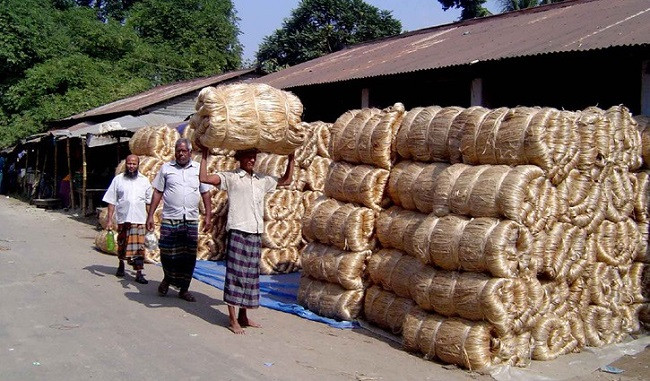Last year at the beginning of the season, the price of jute raised up to Tk 3,200 per maund (1 maund=37.32kg). At the beginning of this season, the highest price was Tk 2,700 per maund. Currently the price has come down further. Farmers are losing interest in jute cultivation due to this.
Traders said that India was the main importer of Bangladeshi jute last year. The demand for both jute yarn and raw jute from India has decreased. And locally, the use of jute ‘chat’ and sacks is decreasing. Plastic products are taking place of jute. Due to these reasons, the price of jute has decreased compared to last year.

Talking to the jute farmers, it is known that per bigha of land (1 bigha=1337.80 square meter) costs about Tk 29,000 to grow 8 to 10 maund of jute on an average. The price of the best jute in the market is Tk 2,400 taka. According to that per bigha jute cultivation is causing a loss of five thousand taka per bigha.
Analyzing the data from the Baneshwar market of Puthia in Rajshahi, Ghior jute market in Manikganj and Rajbari jute market, almost the same figures obtained.
Basically, the price of jute has decreased due to two reasons, firstly-the global recession has reduced the export of jute to Turkey and India, the major importer of Bangladeshi jute, and secondly-due to the water crisis, the quality of jute has deteriorated. Apart from these, many local traders are not buying jute this time as government jute mills have been declared closed. This also has reduced the price of jute in the market.
Mizanur Rahman, Chief Jute Inspector of Faridpur Jute Directorate, said, “There was not enough water in many areas to rot jute this year. This worsens both the color and quality of jute. If the quality is not good, jute cannot be exported abroad. Again, due to the Russia-Ukraine war, jute exports have decreased a lot. Due to this, jute could not be exported abroad as expected.”
Abul Kalam Azad, Deputy Director of Rajbari District Agriculture Extension Department, said that the global recession is one of the reasons for the low price of jute. Apart from this, the quality of jute is also a big issue. Currently, the best jute in the market is being sold at Tk 2,500 per maund. But such jute is very few.
Talking to the farmers of these regions, it is known that jute was sold for Tk 3000 per maund last year. The cost has increased this year as prices of fertilizers and medicines and wages of workers have increased and for this the price of jute should be higher than the previous year. However, adequate water was not available to rot the jute properly. Due to water crisis, both the color and quality of jute is hampered in this season.
Again, due to water shortage, many jute farmers sold jute from the land. As a result, some seasonal jute traders emerged overnight who started buying jute directly from the land and renting ponds to rot and sell the jute. These new traders also suffering losses.
However, the jute fiber in Jessore region is good, but the sudden fall in the price of jute has worried the farmers. Though, in this region too, farmers had to face adverse weather conditions at the beginning of cultivation. Jute seeds had to be sown with irrigation due to lack of rain, and occasional irrigation during drought, which increased cost. But jute was sold at Tk 2,500-2,600 at the beginning of the season, and now it is selling at Tk 1,900-2,000 per maund.
According to the tenants of huts, farmers and jute traders, the demand for jute has decreased along with the closure of the government jute mills. As a result, local jute traders reduced buying jute.
All in all, jute growers are disappointed in this season. Due to losses, many farmers are losing interest in cultivating jute for the next season. Again, many jute farmers have taken loans, which have to be repaid by selling them. Concerned persons claimed that if the consumption of jute products increases, the demand and prices will increase as well and this will encourage farmers further to cultivate more jute.
















